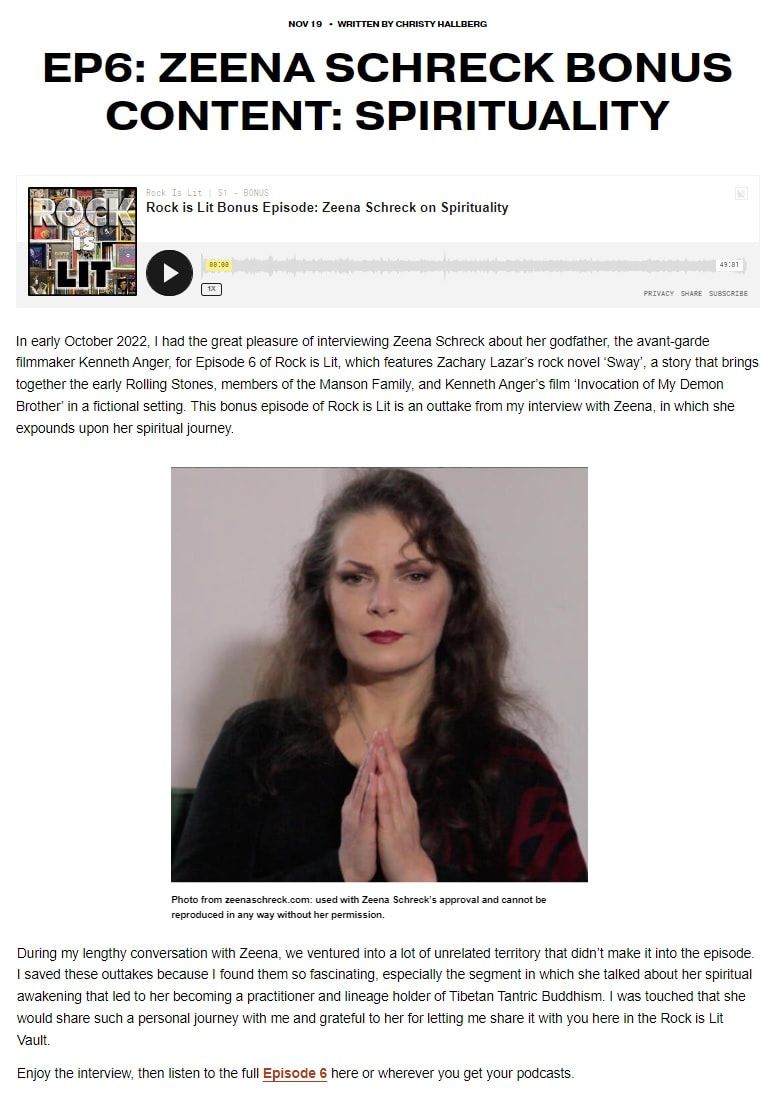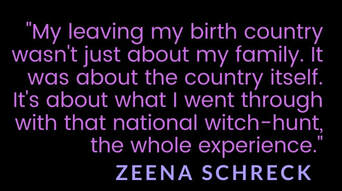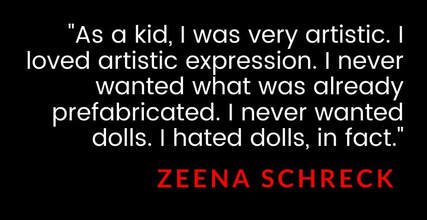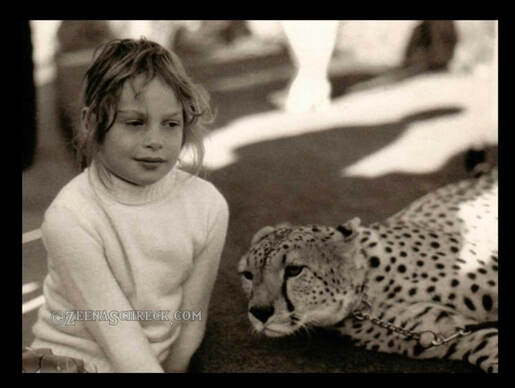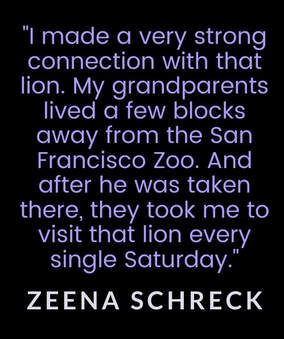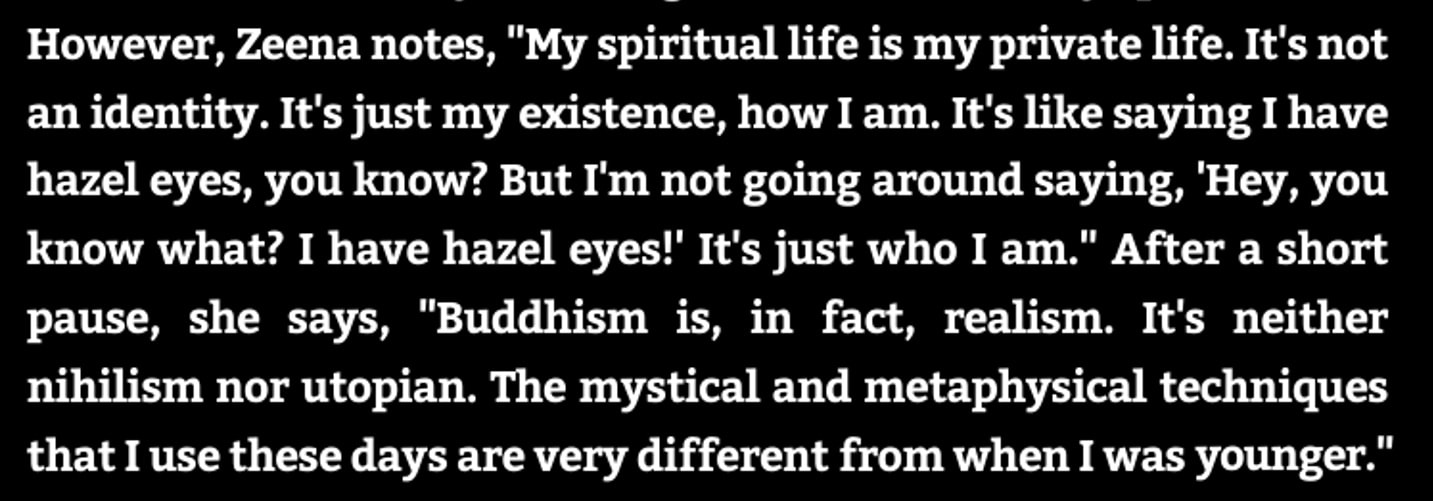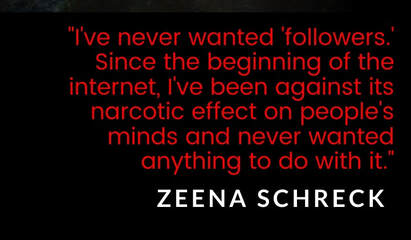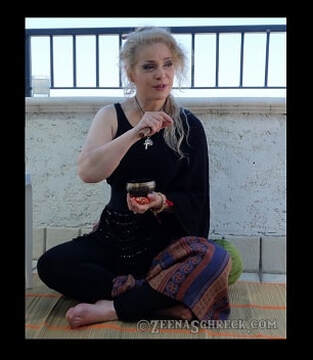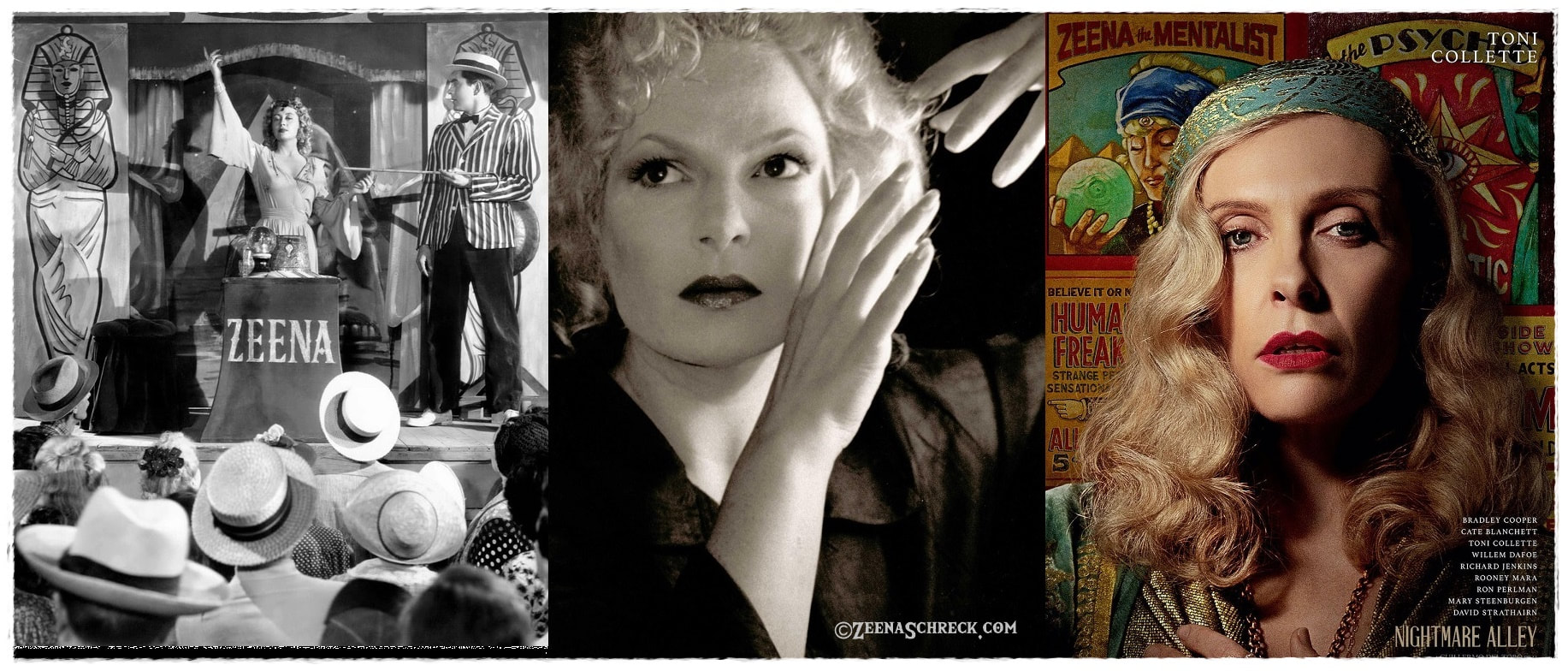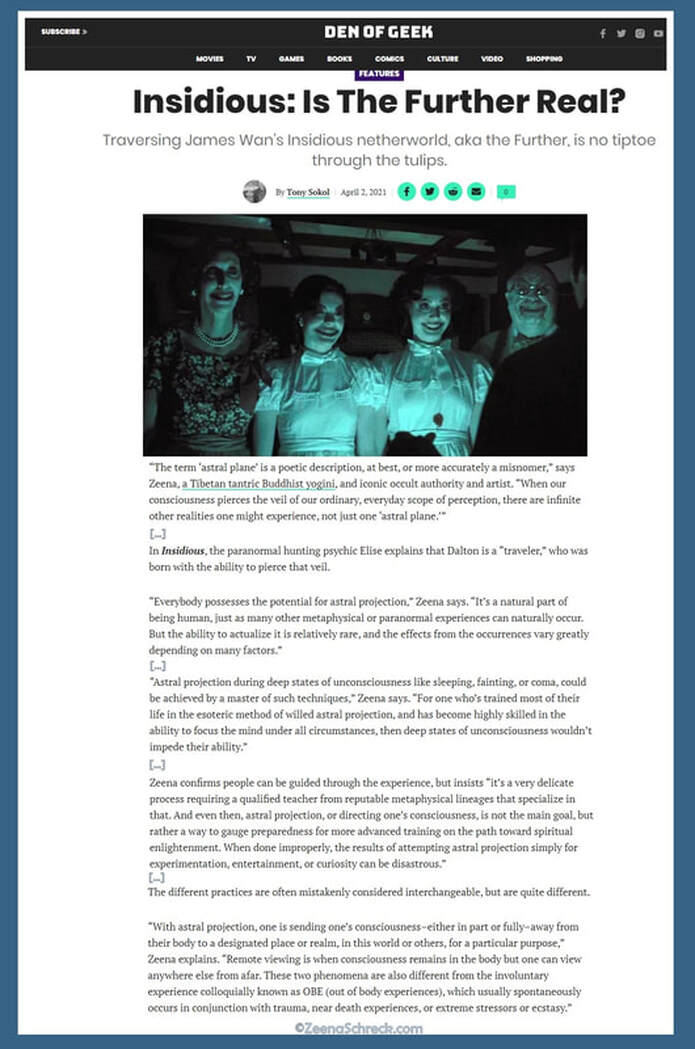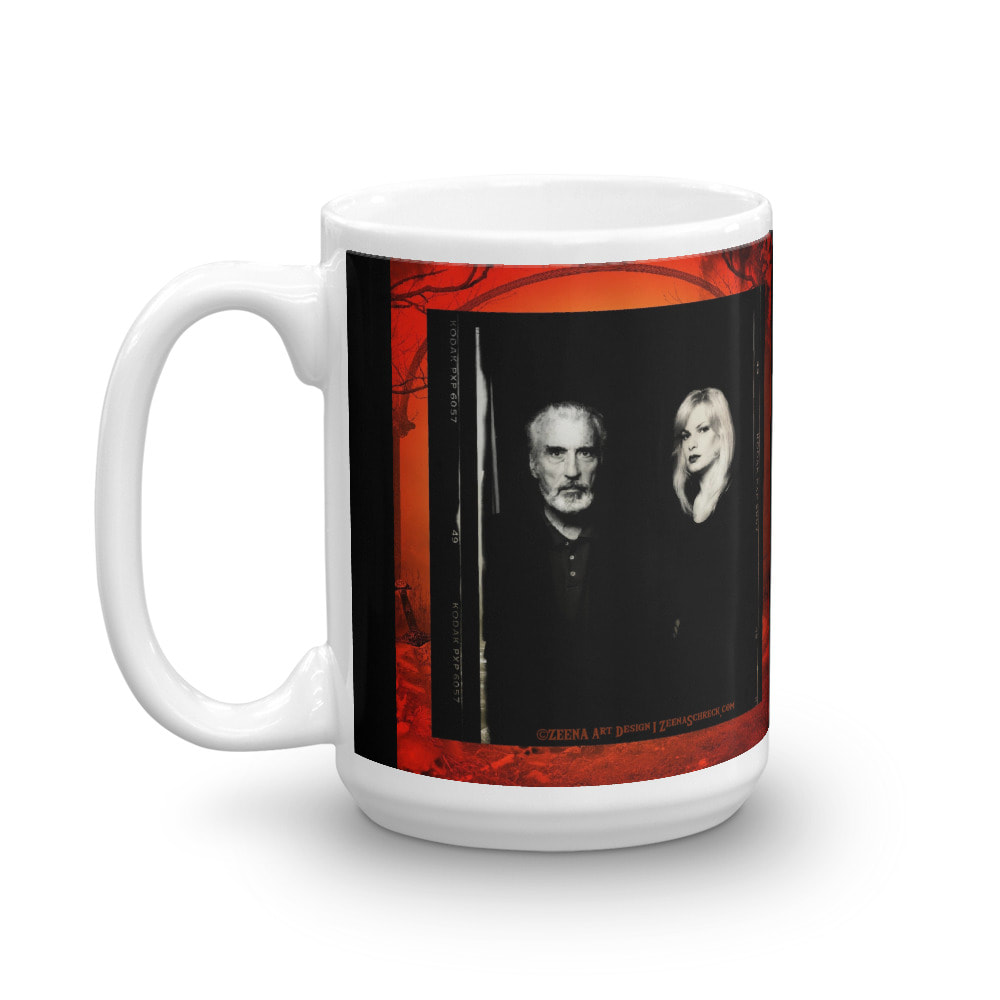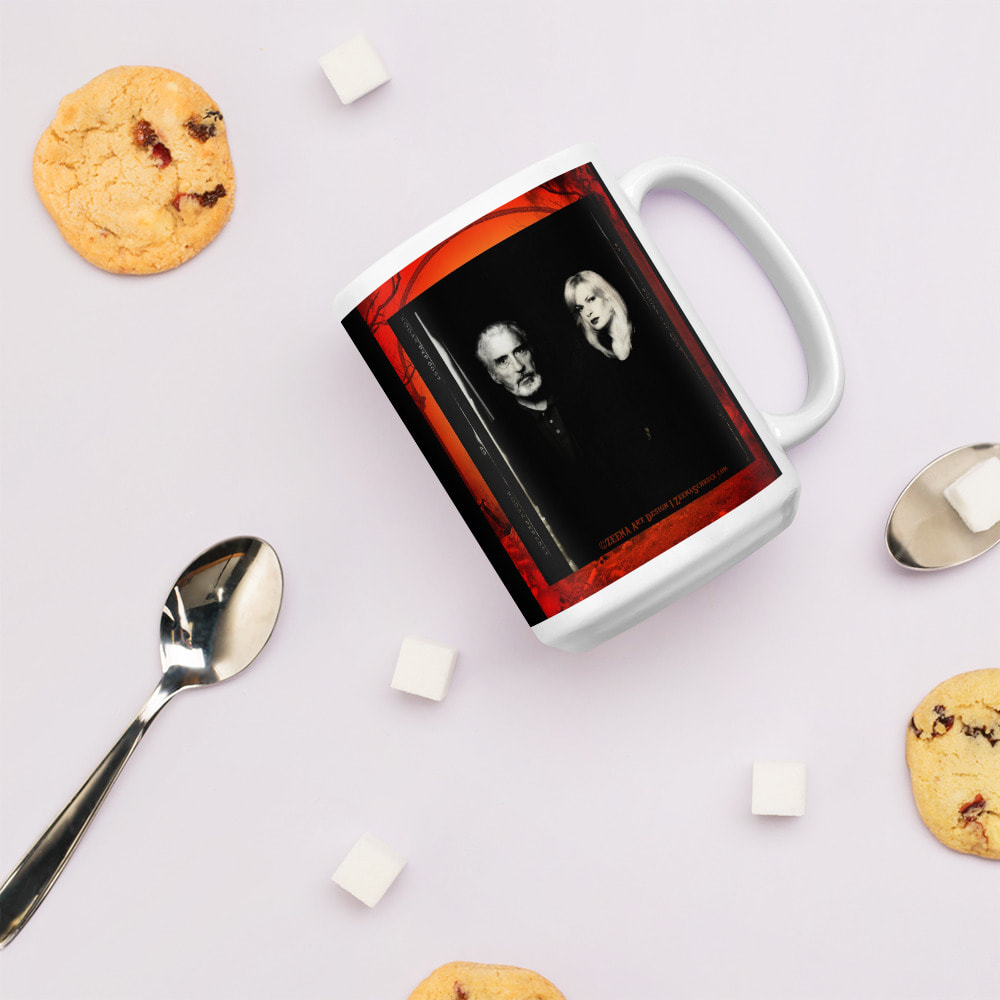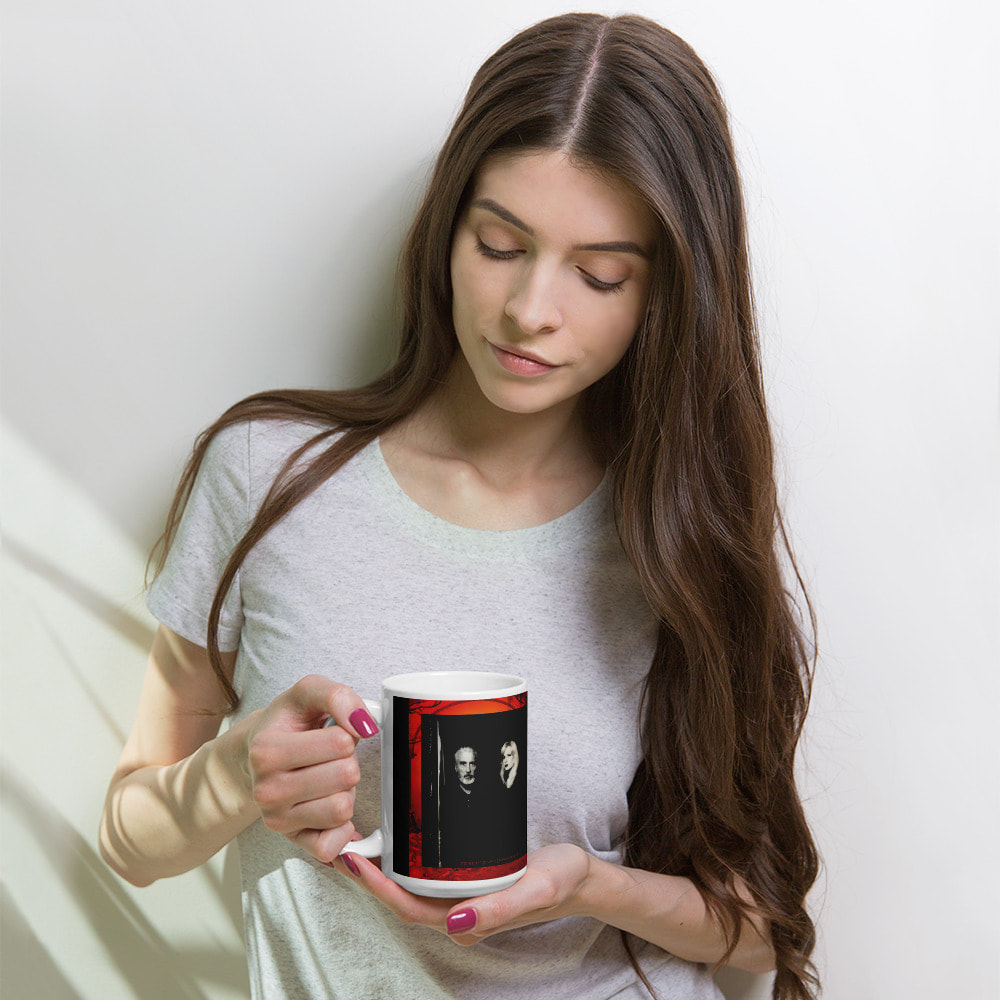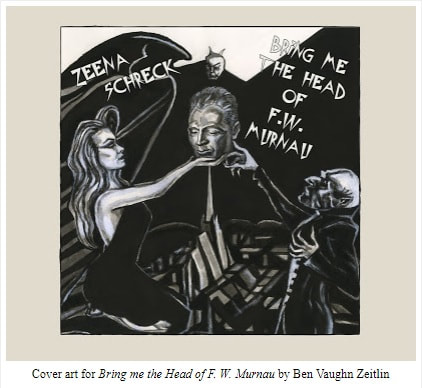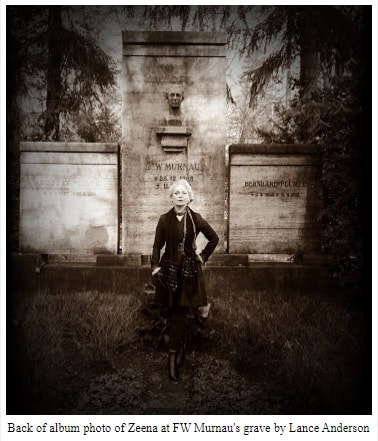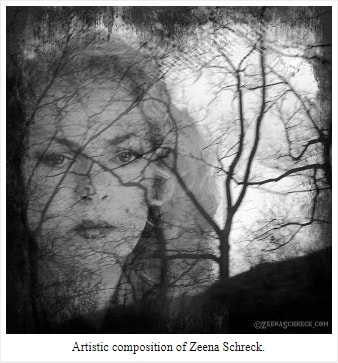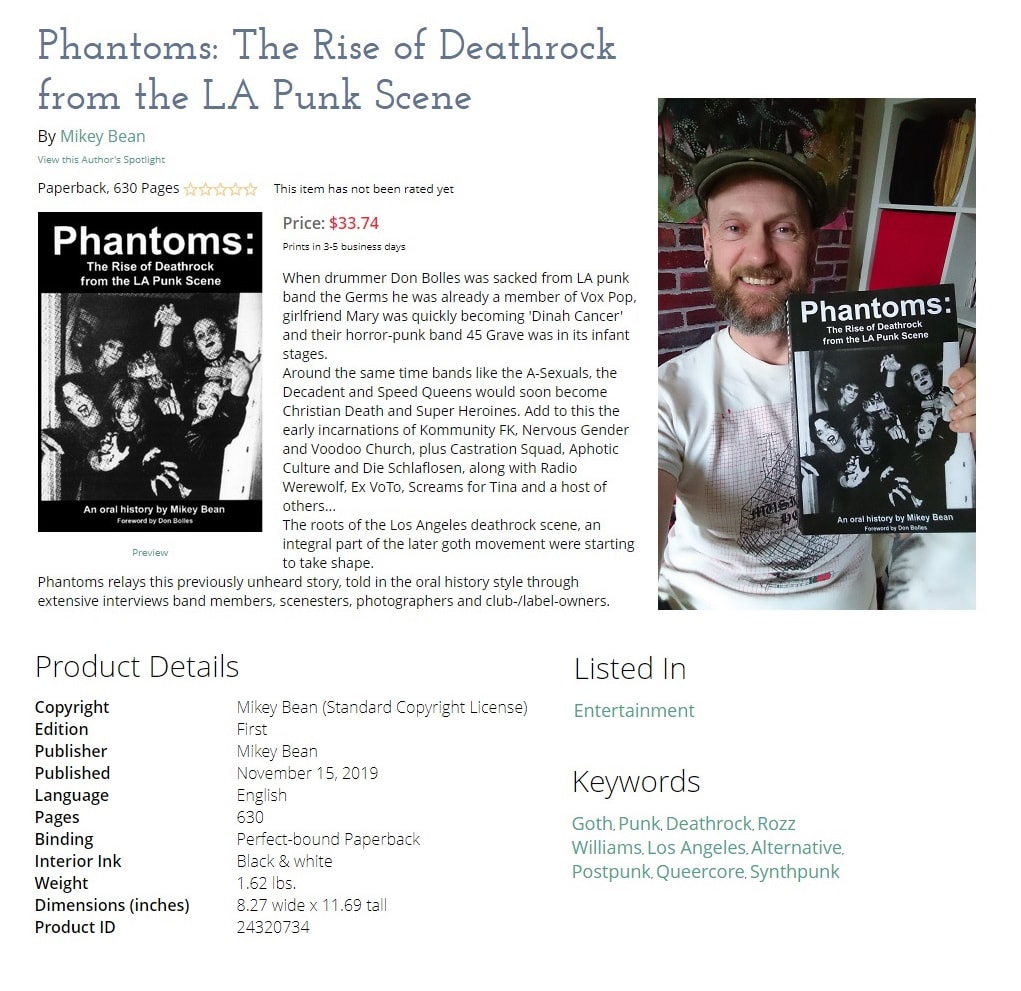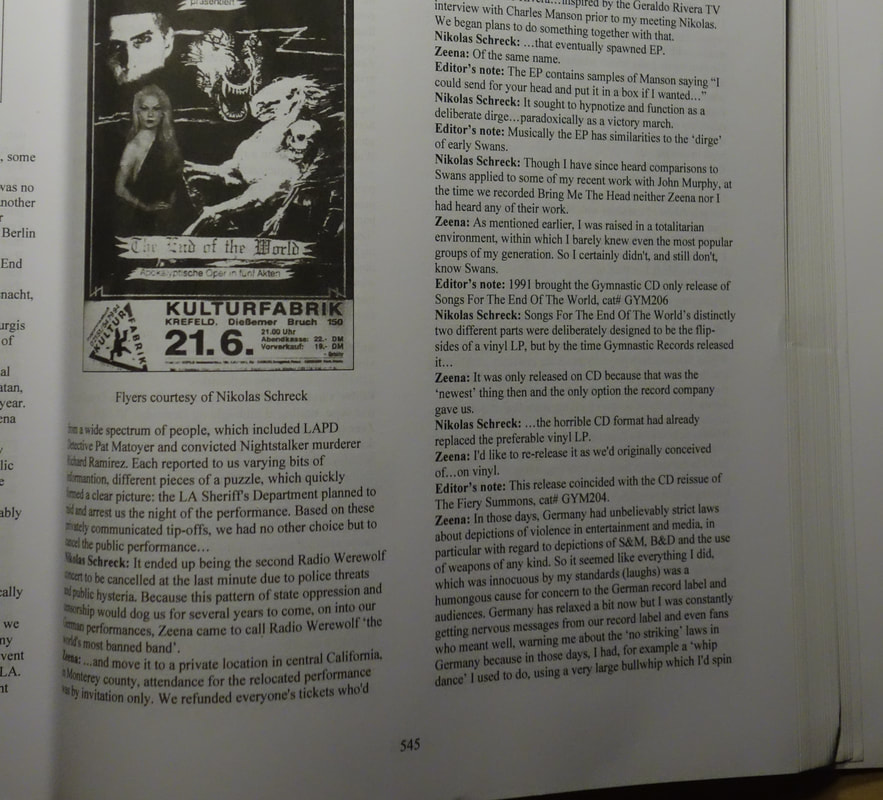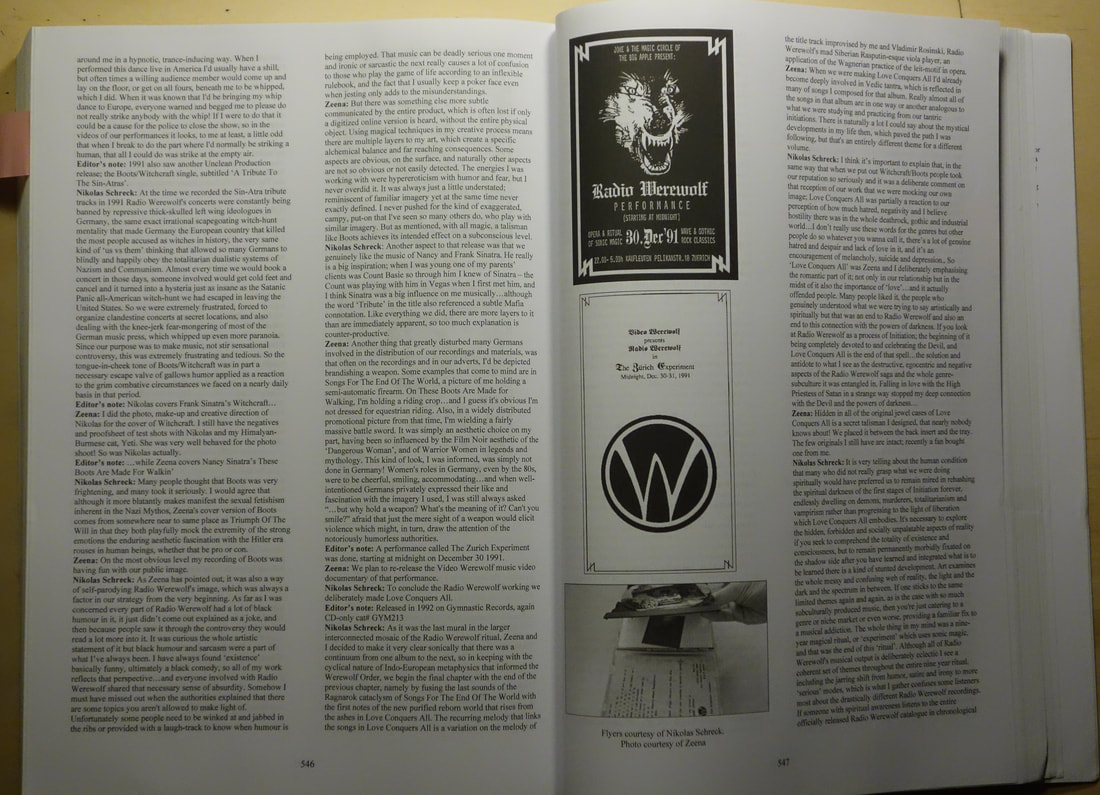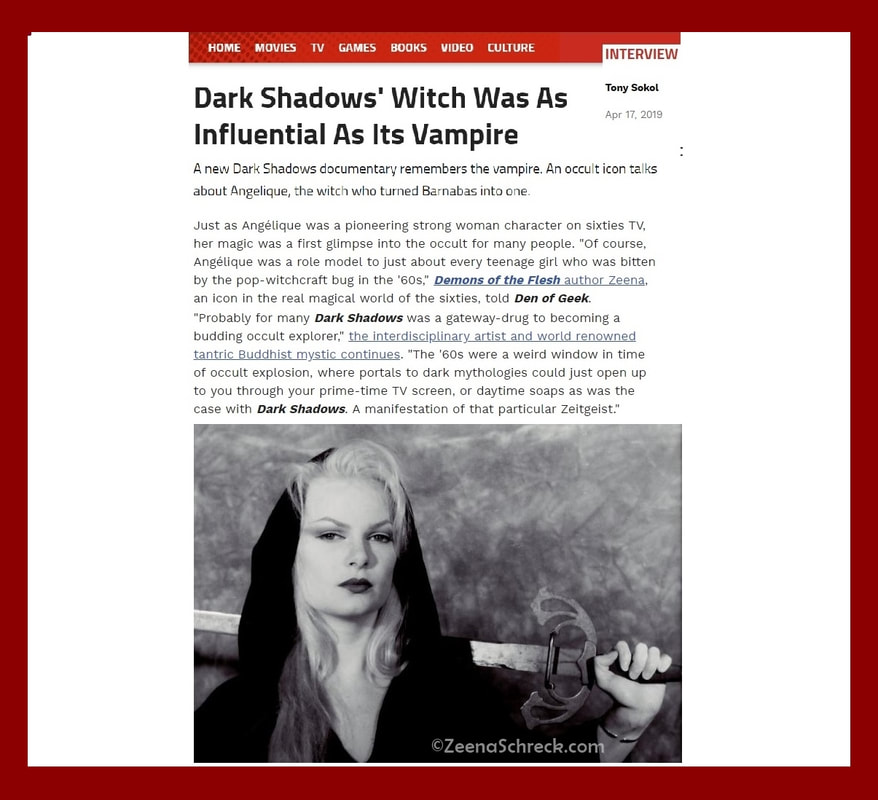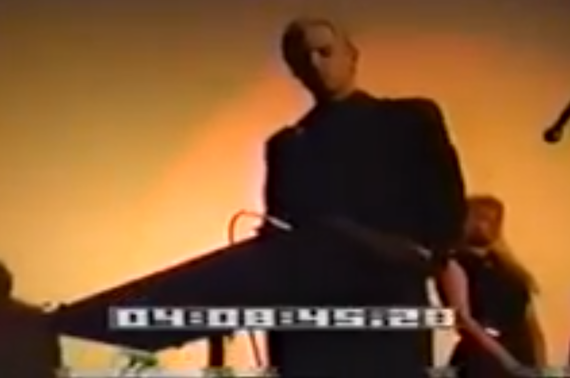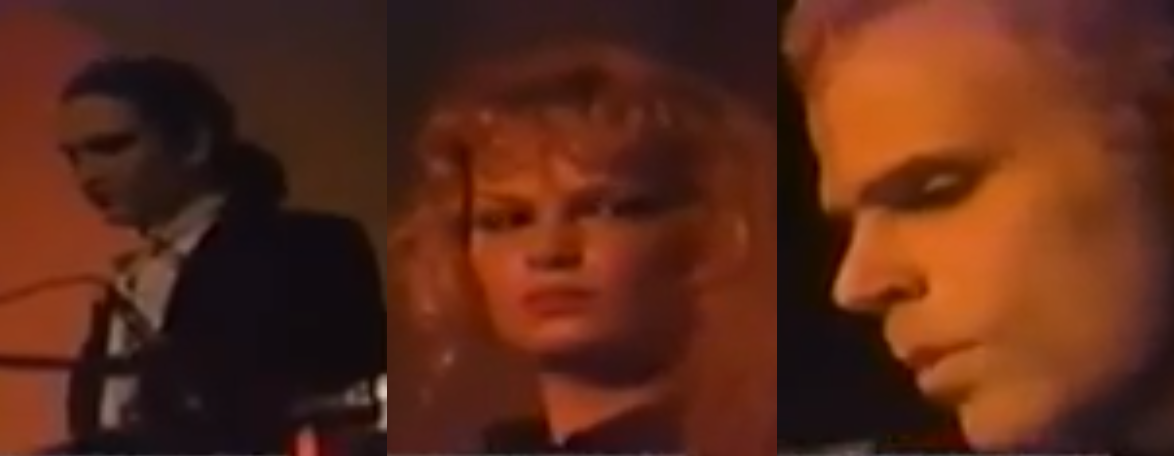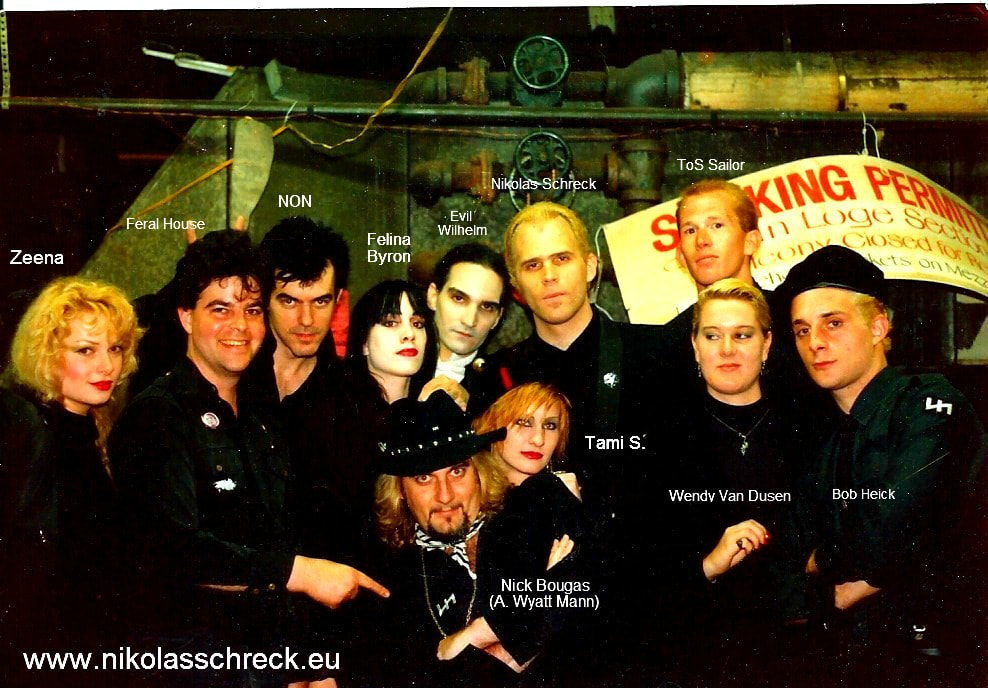 Author G. Connor Salter reached out to Zeena for this in-depth interview which extrapolates on the psychological and philosophical underpinnings of her father's choice to name her after the mystical fortune teller character, Madame Zeena, from the novel Nightmare Alley by William Lindsay Gresham. In the interview, Zeena covers her father's claims to have personally known Gresham, details about his early life history, his brushes with occult and esoteric groups in the '50s and other Noir influences on his early development, which in turn influenced Zeena's early development, making this a richly detailed and insightful exploration into the mind. The article also features photos of two vintage paperback editions of Nightmare Alley and a movie poster for the 1947 film, which lived in the kitchen of the Black House (Zeena's childhood home), from Zeena's personal archives. G. Connor Salter is known for his exhaustive research in and written contributions to scholarly studies of the 1930s-40s literary group The Inklings and by extension CS Lewis's wife Joy Davidman's first husband, Noir author William Gresham. Salter is currently working on the unpublished writings of Gresham to which this interview is a small portion of a larger project. Read the full interview here: punknoirmagazine.wordpress.com/2024/05/22/a-conversation-with-zeena-schreck-about-nightmare-alley-by-g-connor-salter/ [Posted by T.M. 24/05/24]
1 Comment
Signed and numbered print edition 2012 Vice Magazine 'The Showbiz' Issue, Volume 19 Number 4 Zeena's in-depth interview by Annette Lamoth-Ramos featured in this issue was the first after many years hiatus from mainstream media spanning her early life until the early '00s. After much interest and feedback generated from this interview, VICE invited Zeena to write her own column, 'From the Eye of the Storm' . In February 2024, VICE media announced they are stopping both the online and print magazines. BUT we have unearthed a limited number of print copies - 10 in English and 13 in German - all in original (not pre-owned) condition. Signed and numbered on the lead photo by Zeena, there's also an option to have it personalized on the TO ORDER PAGE. The Showbiz issue also features 'The Sordid Secrets of Babylon,' an interview with Zeena's godfather, Kenneth Anger (February 3, 1927 – May 11, 2023), who passed away exactly one year ago. [Scroll down to table of contents to see other articles in this issue.] Condition: Original, Mint to Very Good. Excellent binding, pages are unmarked and clean. Binding: Softcover High quality six-color printing on all pages, glossy cover. 114 pages. 8½”x11” / 21½cm x 28cm. The only differences between the English and German versions are: The English edition originally came with a paper wraparound advertisement on the cover for the action-adventure game Dishonored (see image). To offer collectors this item exactly as it was when it hit the stands twelve years ago, we're leaving it on. The German edition doesn't have any advertising on the cover but features a short write-up about photographer Florian Büttner, who did the photo shoot with Zeena and who gives his impressions of that experience. (See image below for the original German text, English translation follows.) This is photographer profile is only in the German edition and not included in any of the other VICE language editions of the same issue.  Text translates to: “Florian took pictures for us of Zeena Schreck, the apostate daughter of Church of Satan founder Anton LaVey. In Satanist circles, just mentioning her name leads to premature ejaculation. She is a kind of devilish demigoddess who probably desecrated hosts for the first time as a four year old and, at least until she broke away from her father, was on a first-name basis with Belial. Florian met her in a fairy-tale forest at Lake Grunewald and told us that it was quite a dichotomous experience, as on the one hand she looked like the evil stepmother from Cinderella with her baroque dress and stern appearance, yet on the other hand she spoke like the Buddha.” [Posted by T.M. 10/05/24]
Christy Hallberg shares bonus content from her interview with Zeena!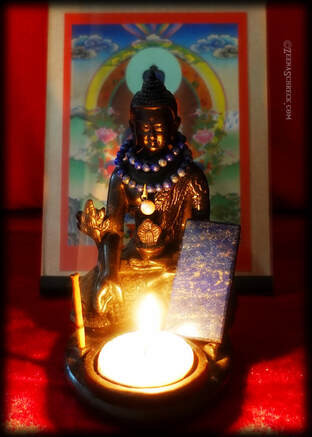 From Rock is Lit: "So much of Zeena’s art converges with her spiritual practice. This is definitely true of [her latest album] ‘Transcend’. To celebrate the release of this amazing album, have a listen to this outtake from my interview with her from Episode 22 where Zeena talks about her new album ‘Transcend’, the use and power of Medicine Buddha mantra for spiritual and physical healing, energy transference and mantras as a means for energy transference, approaching Medicine Buddha in the spirit of receptivity and experimentation, the importance of having compassion—even for negative forces—and more. Zeena has been on the podcast a few times, and each time our conversation tends to branch out and take on a life of its own, which means I always have some bits that don’t make it into the regular episodes, many of which wind up as stand-alone mini-episodes, like this one." -Christy Hallberg Direct link to the bonus interview from Episode 22: https://www.christyalexanderhallberg.com/podcast-vault-feed/zeenaschreckandmedicinebuddha Direct link to the original interview in the second half of Episode 22, in which Zeena talks about the power certain songs have in spiritual and magical practices, with relation to the plot of Rob Errera's novel Hangman's Jam: https://www.christyalexanderhallberg.com/rockislitpodcast/roberreraandzeenaschreck Direct link to order Zeena's new album Transcend: https://zeenaschreck.bandcamp.com/ Sonic Magic with Zeena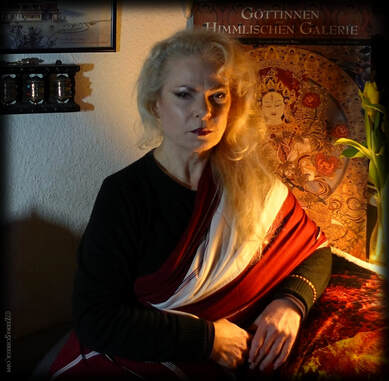 In this week's 'Rock is Lit' podcast episode #22, Christy Alexander Hallberg invites Zeena back to the show to explain how and why certain music can have profound effect when composed and/or performed in combination with spiritual and magical practices. To listen, open the link at-->Rock is Lit, Episode 22 with Zeena Schreck Speaking of magic and mysticism in music, this Friday, March 3rd, Bandcamp is waiving the artists' fees on all music sales! If you haven't already, this Friday's a good day to purchase Zeena's music, as well as your other favourite artists at Bandcamp! You can also follow Zeena's Bandcamp to get notified of upcoming new music releases! [posted by t.m.] Christy Alexander Hallberg of Rock is Lit explains:"In early October 2022, I had the great pleasure of interviewing Zeena Schreck about her godfather, the avant-garde filmmaker Kenneth Anger[...]. During my lengthy conversation with Zeena, we ventured into a lot of unrelated territory that didn’t make it into the episode. I saved these outtakes because I found them so fascinating, especially the segment in which she talked about her spiritual awakening that led to her becoming a practitioner and lineage holder of Tibetan Tantric Buddhism. I was touched that she would share such a personal journey with me and grateful to her for letting me share it with you here in the Rock is Lit Vault. Enjoy the interview, [HERE] then listen to the full Episode 6 here or wherever you get your podcasts." -- Christy Alexander Hallberg To hear the interview click on the screenshot below and scroll to end of this post for personal message from Zeena! Message from Zeena: My heartfelt thanks to Christy Alexander Hallberg for publishing the outtakes from our interview. As is often the case when being interviewed, off-topic questions organically come up and in this case Christy was able to inadvertently document what many have asked me about but which I haven't publicly discussed - my spiritual path and how I got to where I am now. As Christy presented this additional interview material to me as a birthday present, I not only thank her sincerely for that but also hope that anything of what I said is of some benefit to others on their own spiritual journey. Remember that every day you wake up and have the advantage of being alive, in a human body with human conscience and cognizance, and all the potential that comes with that, is a gift and a chance to begin a new life of your choosing. And last but not least, because my root Lama, who I speak of in this interview, also has his birthday so close to mine (same time of the year), I extend all the best birthday wishes and long life prayers to the Very Venerable Thrangu Rinpoche who turns 91 in a few days! Below is a video of last years prayers to him by his monastery in Canada. For those unfamiliar with Tibetan Buddhist types of liturgies and rituals in this video, this gives an idea of the practices to which I'm initiated, for which I'm so very grateful! As we enter into the dark months of the year, may your heart be filled with light and non-judgment and you become a beacon of radiant compassion and loving-kindness to all sentient beings around you. -Om Mani Padme Hum- Zeena P.S. As I first listened to the interview, the point where I'm describing the intermediate state of consciousness between one life before reincarnating into the next life, in Tibetan Buddhism known as the Bardo Thödol, which spans forty-nine days, I noticed that the total running time of this interview coincidentally came to forty-nine minutes! [posted by t.m.] Christy Alexander Hallberg interviews Zeena for Rock is Lit Podcast, Episode 6, focusing on rock novel ‘Sway’ by Zachary Lazar. Hallberg states, “In the final segment, I was so privileged to get the chance to talk with Zeena Schreck who was kind enough to share her memories of Kenneth Anger and her insight into some of his iconic films, especially the 1969 'Invocation of My Demon Brother', a movie that is the connective tissue of 'Sway'. Believe me you don't want to miss this episode.” 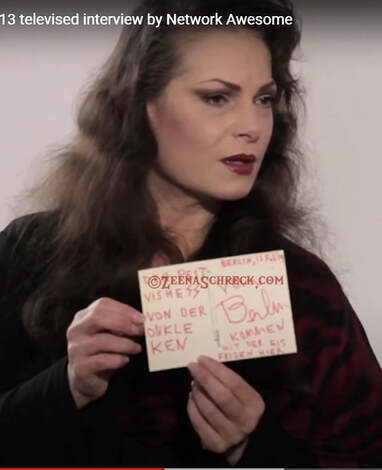 Rock is Lit Podcast description: “Zeena Schreck, who is an artist, musician, Tibetan Buddhist yogini, and the goddaughter of Kenneth Anger, as well as former High Priestess of the Church of Satan (founded by her late father Anton LaVey), shares her memories of Kenneth Anger, including how her father made him her godfather and her personal and working relationship with Kenneth. She also talks a bit about her background and rebuilding her life as a Buddhist in Germany. In addition to this, Zeena discusses Kenneth’s interest in Aleister Crowley; the making of and background on some of his iconic films, especially the 1969 film ‘Invocation of My Demon Brother’ (a movie that figures large in Zachary Lazar’s novel ‘Sway’); Kenneth’s relationship with Anita Pallenberg and her influence on the Rolling Stones; and how Kenneth’s work influenced MTV and music videos.” Zeena's part begins at the one hour mark: www.christyalexanderhallberg.com/rockislitpodcast/zacharylazar/tonysokol/zeenaschreck
In addition to the main interview, don't miss the bonus material with show notes and special photos from Zeena on the Rock is Lit Vault page : https://www.christyalexanderhallberg.com/podcast-vault-feed/zeenaschreck Zeena's music "Summer Swelter" and "ENDLICH DAHEIM”, from ‘Bring Me the Head of F. W. Murnau’ are segmented in her interview. [posted by T.M. Thursday 13 October, 2022; 15:50] 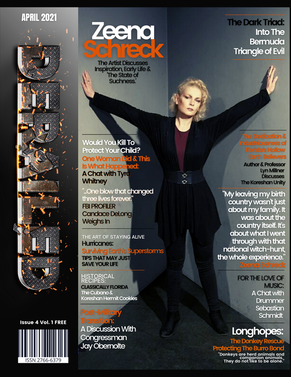 Zeena Cover Story in Derailed Magazine: Since the publication of this extra-long interview with Zeena for Derailed Magazine, many have requested to read it in a more user-friendly format. Specifically, some found the version on the Derailed website difficult to open and navigate to read all the way through whereas some non-native English speakers expressed that they would have liked a way to read the text through translation apps. For those reasons, we're archiving the complete interview text below in this post. The original full color hardcopy of the magazine (containing visuals not included in this post) is available at: https://www.derailedmagazine.com/april-2021 Many thanks to Daphne Minks Daly at Derailed Magazine for facilitating this in-depth, exclusive interview with Zeena! [Posted by Thomas] Eager Student, Humble Teacher Issue 4, Vol 1 April 2021 Words by Daphne Minks Daly. All Images copyright Zeena Schreck. Zeena Schreck has held many titles, avant-garde artist, musician, author, spiritual leader, and High Priestess, to name a few. These days, professionally, she's simply called ZEENA. Of all the monikers she's donned, the one that is truly her most beloved is, of course, that of yogi, or in its feminine form, a yogini. She states, "My life has taken a turn. One where I'm 'becoming.' I'm a yogi that lives out in the forest. I live a solitary existence. And that's somewhat necessary for the kind of spiritual path that I'm on." Her private existence makes penetrating Zeena's inner circle a difficult but not impossible task. These days, she's kept well-insulated from outsiders, and it's of little wonder why. In the eighties, her father's religious organization was the center of controversy and a worldwide media nightmare, thrusting her already highly publicized family further into the spotlight. Ultimately, at her father's behest, Zeena publicly took up for him and his organization, taking the heat for both while becoming its first public spokesperson. Although she resigned from her role and severed ties with her father in 1990, many people still mistakenly associate her with events leftover from decades ago. In many ways, the shadows of her past will always be there. In other ways, they're all but a faded memory. Her childhood house, which once stood in San Francisco, California, was demolished in 2001. Known globally as The Black House, the building was, for many, a symbol of opposition and religious freedom. For others, blasphemy, fear, and hatred. But, despite the controversy, for Zeena, it was just home. Refusing correspondence that addresses her by previous surnames or titles, she has done her best to distance herself from her former identity. A permanent resident of Germany for well over two decades, Zeena says, "My leaving my birth country wasn't just about my family. It was about the country itself. It's about what I went through with that national witch-hunt, the whole experience." The former High Priestess affirms, "In the eighties, there were so many factors that came together, that caused good reason to travel a very extreme distance. My mind was made up. And that was it, I just had to get away. And sometimes you have to go very, very far away in order to get your life and head together." Zeena thoughtfully explains, "I often compare that experience to a branch on a tree. The tree, representing the family, maybe has root rot and it's beginning to reach up through the trunk of the tree as it's growing. The root rot is beginning to infest with parasites and it's actually toxic and rotten. Yet, there are a couple of branches, maybe close to the top or sticking out at the side, that the root rot hasn't reached fully. It's getting close, but if you can snip them off and replant them maybe they've still got enough life in them that the toxic effect hasn't reached them completely." Continuing, she says, "Snip it off, replant it, get it into healthy soil with some sunlight and nutrients. Then that branch of the tree can grow and get healthy. But first, it has to be separated from the rot. I feel that about my life here in Europe, that I returned home. That I actually was in the wrong place before." Her artwork speaks to an old soul with an appreciation for German romanticism. Stating that her inspiration comes from a comfortability with solitude and vivid imagination skills, Zeena shares, "As a kid, I was very artistic. I loved artistic expression. I never wanted what was already prefabricated. I never wanted dolls. I hated dolls, in fact." She remarks, "What I really wanted was art supplies. Or... and this may sound weird, but things that were just for 'survival.' One year, I asked for an icebox so I could keep food in my room, to begin learning how to live on my own. I wanted to know how to be utterly, utterly self-sufficient." I wondered about her childhood and how growing up in The Black House may translate to her art. "Was I ever a child?" Zeena sarcastically asks herself before responding. "I was left for pretty much the whole day, everyday. My sister would be in school and my parents slept through the day. I developed the necessity, but also the ability...well, I mean, I had no other choice than for my imagination and mind to expand," she explains. Pondering for a moment, Zeena recalls, "Because they slept all day, my mother would leave my breakfast on a chair next to the crib so when I woke up, I could reach out and take it. She used to brag to her friends, 'Oh, Zeena! She's like a little monkey. I have her so well trained, she can feed herself.'" Clarifying, she says, "My parents were not 'kids' kind of parents, you know? I didn't really spend a bunch of fun time with them, unless it was my birthday, or a holiday or some other reason. Otherwise, I was very much left to my own devices. I developed the ability to entertain myself." Zeena remarks, "My mother didn't know what I was interested in. She was just working all the time. I would only associate quality time with her after a big blowup between my parents." Her father, she explains, contributed to her interest in art and music a great deal. "In my earliest life, he definitely spent more quality time with me than my mother, with things that interested me. He would play music or after dinner he'd sometimes draw with me and teach me about classical art and music. He hated rock and metal music and gave long diatribes about how stupid it was. So, I was raised with very traditional musical influences. My father's original profession was musician. That's what's written on my birth certificate, as his profession. That's what he did back then," she says, her voice softening. Zeena then remarks, "I started reading fairly early, thanks to my grandmother. Every weekend, when I went to their house, she would get me a new book from that series, Little Golden Books. The fairy tale books that I was reading, my mind would wander and kind of discover alternate realities." She finishes her thought by sharing, "In my earliest life, my grandparents were that little bit of stability in my life. Because they led a 'normal, regular life.' There were a lot of changes that happened very rapidly throughout those early years. In my life, in my family, and in my household." When I ask about her experiences attending school, Zeena's gentle but nervous laugh makes another appearance. She replies, "For the longest time, for the life of me, I could never remember my first day of school. But, when I was dealing with issues after leaving my family, I learned some self-hypnosis techniques. I began uncovering a lot of just very mundane, ordinary memories. One of the things I realized was why I couldn't remember my first day of school. It's because I didn't go." Zeena explains, "My mother wasn't aware that school had started. So, I started late. I'm pretty sure it was a couple of weeks late." She goes on to say, "I spent so much time alone and was not socialized very early in life. It was a big problem when I started school. I was a little like a wild animal. I didn't really know how to behave for school." Recalling her first day at school, she describes, "All the other kids were already well-trained. The teacher said, 'We're going to get graham crackers before we take a nap.' And everybody got into 'formation,' to get their crackers. I didn't know the concept of science fiction, but it was all just weird!" she laughs. "When the teacher said, 'It's time to take a nap with your head down on the desk,' I wouldn't put my head down. I thought, 'I want to go outside and play!" She points out, "Of course, given the philosophy that I was raised with...that my parents made clear in interviews, and this is their words, by the way, they raised me 'by the laws of the jungle.'" She explains further, "I was able to be very independent and of course, that made my parents very happy - less work for them. I always kept to myself. I was always a loner. Unfortunately, that made me easy prey to be picked on and taken advantage of in a lot of ways. So, I learned how to fight early too," Zeena says. "Most of my life I hated school, but it wasn't that I hated learning. It wasn't that I didn't like my teachers. It was just...the problems I had in school because of my parents' notoriety, definitely caused serious problems for me. So, I took the GED to get out early," she shares. Zeena details, "It wasn't until much later in life that I could unravel how much of my behavior was a reaction to the way I was treated by other kids, and societal influences. And how much was inherent to my natural character." She discloses, "I've always had one or two very close friends, and I'm still that way, actually. I was never one of these girls that had a gang of girls they hung out with or some club at school that was their own clique." She expands by saying, "The only places I can recall that I felt safe was with a favorite uncle and two particular friends in my neighborhood. I always used to wish that they would just adopt me." With a childlike chuckle, she elaborates, "I was the stray dog at their door at dinner time. Like, 'Can I just kinda hang out here for a while?" About her childhood friends, she shares, "Their parents were kind enough to give me a little refuge, some shelter, even if just for a few hours, it was enough for me to get a breather." Taking a more serious tone, Zeena says, "Although I, myself was not a victim of parental physical abuse, there are many studies showing the effects of domestic violence between parents on the children." The artist emphasizes, "Even if the children are not being physically beaten themselves, it's just as damaging. Because they're living in a constant state of anxiety, of never knowing when something's going to blow up or where they stand. The stability of the household is totally shot." In the early years, death threats, nightly vandalism, stalkers waiting outside of the home, and hate mail were common occurrences due to her parents' notoriety. Zeena highlights, "In my case, I not only had violence in the household but violence outside of the household as well. I really had nowhere peaceful." "I used to feel like a lone wolf or a jungle cat that must fend for itself, like a jaguar," Zeena details. "I had a very strong connection to animals and still do obviously. My connection to other humans was far weaker. It probably still is," Zeena admits. "I so identified with animals. As I said, I was not socialized when I was a kid. But we did have a lot of animals and I was really tightly linked to them. Not only to our animals but to all animals." Her family's various exotic pets were also the source of another much-publicized debate. Most of the focus was placed on the family's pet lion, Togare. Zeena remembers, "I made a very strong connection with that lion. My grandparents lived a few blocks away from the San Francisco Zoo. And after he was taken there, they took me to visit that lion every single Saturday." She maintains, "I came to know Togare better than my parents did, after so many years," recalling, "My parents just dropped him there. They never went back to visit him. So, I was visiting regularly, making a shamanic connection. He was my brother. We were both just show-things in my parents world." The avowed vegan and animal rights advocate quickly points out that she doesn't condone keeping wild animals as personal pets. Expounding on her connection to animals and how it relates to her Tibetan Buddhist practices, a distinct sound of joy lifts in her voice. Zeena explains, "Part of what I teach is healing practices for people's animals." She says, "I really enjoy being able to guide people through certain spiritual practices, who maybe have an elderly or sickly animal. Or if they've just gotten a new baby animal, I teach how to do certain strengthening and longevity practices. Even choosing a name that will be beneficial to the animal is something Buddhism places emphasis on." Zeena remarks, "I happen to like all creatures, too, even insects that I've never seen before that are kind of creepy looking. I'll have a curiosity and think, 'Wow, that's neat. I wonder what it's thinking right now.' I try to look them in the eye and relate to them on their level." With a tender laugh, she says, "Some people don't respond too favorably when they see that you like singing to an insect, thinking you're a little buggy yourself." She goes on to explain, "Of course, I know the bug doesn't speak English. But you know what? I also know that if you're in a foreign country and you don't understand the language, but someone's genuinely kind to you, you're going to understand it. You don't need to speak their language." Zeena shares, "So often, I hear people coming to me saying, 'I'm so lonely.' Especially in these times, with coronavirus, lockdowns, and everything. People are so lonely. Depression and mental illnesses are getting worse because of isolation. I always try to remind them that if they open their mind up to all the life forms around them, visible and non-visible, it's literally impossible to be lonely." She kindly points out, "There are so many small life forms that you could be devoting your attention to, which could benefit from your positive attention. Just as you're feeling lonely, wishing someone would give you attention, so does that dog sitting next to you, or a spider in your kitchen!" Zeena suggests, "Just talk to them like a normal person talking to another person. They'll feel your intention. They'll feel your kindness. And that whole process transforms you, then you don't feel so lonely." As a yogini, Zeena instructs students privately, teaching Buddhist philosophy, rituals, meditation, and magic techniques. On a secular level, she offers private life-coaching and spiritual-based counseling to anyone of any religion. Offering lectures, seminars, and workshops to the general public, she believes in the importance of continually learning and challenging the mind. Zeena frequently partakes in solitary Buddhist retreats to expand, deepen and master her own practices. "I've been teaching since I was 16 years old. Metaphysics and magical sorcery when I was younger. Not so much sorcery anymore," Zeena clarifies, "but teaching spiritual practices and meditation for a very long time." She describes, "The core of my life is maintaining my spiritual practices. Like the hub of a wheel, from which everything else in life expands like the spokes." Zeena confesses, "Partly my biggest challenge these days, with my own spiritual practices, is compassion for humans. What I mean by that is, to have compassion for humans but not for their disruptive behavior. That is the important distinction." I then inquired about her path toward Buddhism. I wondered what it was that drew her to its time-honored traditions. She replied, "For me, it was the result of several personal tests that I had to go through. My life was changing in such a way that I really needed some spiritual direction of a metaphysical type." "I was not interested in psychotherapy. I explored that earlier in life. It was as good as it could have been for the people who were providing it," she explains. "But, you know, it just didn't work for me. It was not my solution. I had specific things that I was going through in life." She elaborates by saying, "The advice. The empowerments. The initiations, and training that I've received from my Buddhist teachers awakened the ability to make clear spiritual, metaphysical, and even health-related changes more rapidly than ever before." Zeena explains, "The compassionate manner, the way they also taught by example, activated deeper understandings about the true nature of the world we live in. About life in general, and about how the mind operates. That proved to me the pure and magical nature of these Tibetan Buddhist practices, which is still a living thing." She is quick to point out, "As I was undergoing all of these challenges, lessons, training, and initiations this was all interconnected, happening simultaneous to my creating art, which is my profession." However, Zeena notes, "My spiritual life is my private life. It's not an identity. It's just my existence, how I am. It's like saying I have hazel eyes, you know? But I'm not going around saying, 'Hey, you know what? I have hazel eyes!' It's just who I am." After a short pause, she says, "Buddhism is, in fact, realism. It's neither nihilism nor utopian. The mystical and metaphysical techniques that I use these days are very different from when I was younger." Pausing for a moment, she states, "I suppose that's the process of evolution." Continuing her thought, she reflects, "In recent years, the accumulated effects from decades of meditation and other practices have allowed me to transform the process by which I do my art as well. "I do much more observing and listening now," Zeena explains. "I take more time to open my mind up and allow what organically comes up without imputing, forcing, or steering a precise meaning or goal onto something." Elaborating further, she relates, "Sometimes, when something I hadn't initially meant to do develops, which is more meaningful than the original plan, I think, 'Yeah, okay. So, this is what I was really meant to do.'" Zeena tells me, "Observing what naturally arises, it's often not even what is in the forefront that reveals itself as so important, but what's on the periphery or in the background. There are many levels of awareness happening simultaneously." She expounds further, professing, "I have a certain exercise that I guide some of my students through, which I call 'The Incidentals.' The incidentals are not the thing that's in the forefront of your view." Simplifying, she describes, "If you go to the zoo, for example, you go with the thought in mind that you're going to see tigers, bears, and elephants. The 'big things.' You're not really thinking that there's also going to be city sparrows there. Or a mouse stealing from feed trays. Or, other things like the people working there, who you didn't really pay to see. But they're there, also living beings. They're what I mean by 'the incidentals.' It's what we often overlook." She asserts, "Of course, there's much more to this exercise than only that! But that's how my art is ever more integrated with my spiritual practices." "Another aspect of artistic inspiration," Zeena says, "is that I'm very drawn to, and had early life experience exploring symbolism and the Symbolist art movement." There's also a vital source of inspiration that comes from her dreams. She explains by saying, "In that sense, I'm influenced by the same things that the Surrealists and Expressionists were. For decades, I kept a dream diary. Although these days, I don't need to so much anymore." When it comes to her students, I can't help but wonder how she feels about 'internet followers.' Upon asking her about social media and its role in her life, she candidly replies, "I've never wanted 'followers.' Since the beginning of the internet, I've been against its narcotic effect on people's minds and never wanted anything to do with it." Zeena reveals, "The only reason I opened certain accounts, got a website, and began an online presence at all was because there were so many impostor pages... claiming to be me...even speaking as me at times!"
She continues, affirming, "As for my students, I encourage them to refrain from excessive online use, or to develop mindfulness with how they use it. Set a timer and not go beyond a certain amout of minutes per day. Turn everything off at a certain hour, and do whatever is necessary to not get hooked by the toxic influence." Zeena advises, "Taking regular digital detox days or weekends is also helpful. Be as vigilant with online use as you'd be entering into a toxic waste dump. We're already navigating through enough illusions in real life. Letting yourself get caught up in even more illusions through virtual reality is beyond illogical, it's insane. I would not be sad if the whole internet just disappeared tomorrow." Zeena then reflects on a quote she once read in a German magazine. She thoughtfully recalls, "A famous Tibetan Buddhist, The 17th Karmapa, Ogyen Trinley Dorje, was asked if he uses modern conventions like the internet or email. Well, he sort of scoffed and said, 'With whom should I email? The internet only provides the illusion of information. It also creates a lot of confusion.' That quote was such a great little teaching, in and of itself." She remarks, "It's a very sick society that we're living in now, requiring radical rebellion. This is something I try to impart to people I know." Rhetorically, Zeena asks, "What is radical rebellion?" She responds with, "The way to be radical is to stop a lot of insane mind-damaging behaviors that have become addictions. That's how to become radical." Explaining further, she says, "Being radical is getting a grip on yourself, on your mind and not being seduced by the newest, latest thing. Not being emotionally dragged down because you think you should be doing whatever your peers are doing. How to be radical in this day and age is to think of the consequences of your actions. That's how you'd be radical. Don't just do things mindlessly and impulsively." Zeena tells me, "Being radical is stopping destructive, habitual behavior. Don't care about what your neighbors are doing. Don't care about what some politician is doing or saying. Who the hell cares? Care about what you are doing. Care about how compassionate you are to others." She imparts, "A lot of people might think, 'Why should I be compassionate when nobody else is?' Well, when has it ever worked out that two wrongs create a right? Not paying attention or caring about one's own actions and consequences is why the world is in the state it's in." She highlights, "Get yourself healthy. Get yourself as strong as possible... your body and your mind. This is what's radical. Why is it radical? Because it actually requires more mental strength and discipline than just falling apart every time something offends and having a toddler tantrum." Clarifying her thought, she explains, "We enter life, and we're given these identities from our family, from our society, from our schools. The conditioning comes from both outside of ourselves as well as self-generated." Zeena says, "Are you going to go into this profession or that profession? What is your identity going to be? What are your politics going to be? What will be your religion? Or no religion? What are you going to do with your life? We place a lot of thought and expectations into 'I'm this,' 'I'm that,' 'I'm not this,' I'm not that.' She advises, "For those on a true spiritual path, eventually one begins to feel a healthy disgust for all identity labels. You don't want or need them anymore." Expanding further, she explains, "Gradually, all of that begins to drop away. Even your own ideas and definitions gradually dissolve and drop away, so that you don't need to be defined by any comparisons or points of reference." Zeena concludes by stating, "You become pure existence. You just are. In Tibetan Buddhism, there is a way of describing this. My root Lama, Thrangu Rinpoche, explains it as attaining a state of 'suchness.' Such a beautiful word in its simplicity. 'Suchness.' Pure existence. Not this. Not that. Not both. Not neither. Just relaxing in a pure state of being. Simply being." [END] How Nightmare Alley Conjured Real Occult Worship: Den of Geek's Tony Sokol interviews Zeena about how 'the spiritual con at the heart of Guillermo del Toro's Nightmare Alley is based on a story with a strange power and connections to the occult.' Read the full article at https://www.denofgeek.com/movies/nightmare-alley-conjured-real-occult-worship/
Exclusive in-depth seven page interview with Zeena in the April '21 edition of Derailed, a new magazine for cynics, renegades and survivors of the unimaginable, describes the article: "The Artist Discusses Inspiration, Early Life & 'The State of Suchness.'"
"My leaving my birth country wasn't just about my family. It was about the country itself. It's about what I went through with that national witch-hunt, the whole experience." -Zeena Schreck To read online, go to Featured Story in the April 2021 Issue. Order the print edition at: www.derailedmagazine.com/ Film Review of 'Insidious': Zeena Interviewed about Astral Projecting through the Netherworld3/4/2021 Den of Geek magazine consults Zeena about Tibetan tantric Buddhist practices of astral projection and traveling though netherworlds in relation to the new film 'Insidious,' and its portrayal of a realm called 'The Further'.
Selected excerpts of Zeena's interview below. The entire article can be read at: https://www.denofgeek.com/movies/insidious-is-the-further-real/?fbclid=IwAR1Ttsh47-rstZNZkaYLFRfGtGy3RJm0-ym72mraJa6-QhkK_-wrj0KHimo Selected excerpts: DoG: Among true believers, “the Further” is also called Liṅga Śarīra, Akasha, and prana. But it’s probably best known as the astral plane, a shallow tag in itself. “The term ‘astral plane’ is a poetic description, at best, or more accurately a misnomer,” says Zeena, a Tibetan tantric Buddhist yogini, and iconic occult authority and artist. “When our consciousness pierces the veil of our ordinary, everyday scope of perception, there are infinite other realities one might experience, not just one ‘astral plane.’” [...] DoG: In Insidious, the paranormal hunting psychic Elise explains that Dalton is a “traveler,” who was born with the ability to pierce that veil. “Everybody possesses the potential for astral projection,” Zeena says. “It’s a natural part of being human, just as many other metaphysical or paranormal experiences can naturally occur. But the ability to actualize it is relatively rare, and the effects from the occurrences vary greatly depending on many factors.” [...] “Astral projection during deep states of unconsciousness like sleeping, fainting, or coma, could be achieved by a master of such techniques,” Zeena says. “For one who’s trained most of their life in the esoteric method of willed astral projection, and has become highly skilled in the ability to focus the mind under all circumstances, then deep states of unconsciousness wouldn’t impede their ability.” [...] DoG: Zeena confirms people can be guided through the experience, but insists “it’s a very delicate process requiring a qualified teacher from reputable metaphysical lineages that specialize in that. And even then, astral projection, or directing one’s consciousness, is not the main goal, but rather a way to gauge preparedness for more advanced training on the path toward spiritual enlightenment. When done improperly, the results of attempting astral projection simply for experimentation, entertainment, or curiosity can be disastrous.” [...] DoG: The different practices are often mistakenly considered interchangeable, but are quite different. “With astral projection, one is sending one’s consciousness–either in part or fully–away from their body to a designated place or realm, in this world or others, for a particular purpose,” Zeena explains. “Remote viewing is when consciousness remains in the body but one can view anywhere else from afar. These two phenomena are also different from the involuntary experience colloquially known as OBE (out of body experiences), which usually spontaneously occurs in conjunction with trauma, near death experiences, or extreme stressors or ecstasy.” [End of excerpts] 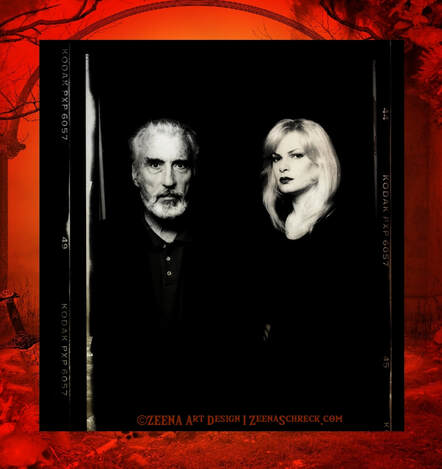 Tony Sokol at The Chiseler Online Magazine interviews Zeena about her memories of actor Christopher Lee: [Begin excerpt] The interdisciplinary avant garde artist spoke exclusively with the Chiseler about the legendary actor. Zeena “met Christopher Lee as a result of being co-producer for the CD ‘Christopher Lee Sings Devils Rogues and other Villians.’ Specifically, I first met him at the apartment in Los Angeles that [former husband] Nikolas and I rented for him and his wife Gitte to stay in while we worked on the recording of ‘Christopher Lee Sings Devils Rogues and other Villains.’ ” Long before Lee recorded with the symphonic power metal group Rhapsody of Fire, he was involved with “Christopher Lee Sings Devils, Rogues & Other Villains (From Broadway To Bayreuth And Beyond).“ “Nikolas knew of Lee’s love of classical music, opera and Broadway musicals. But at that time, the general public only knew Lee for his vampire roles and had little awareness of his musical talent and appreciation,” Zeena explained. Lee maintained that his one regret was his decision not to become an opera singer. “Nikolas conceived of the idea to spotlight Christopher Lee’s considerable singing talents,” Zeena said. “But he knew that to do that effectively, such a project would need to focus on musical selections one would automatically think of Lee singing, appropriately sinister villainous characters from Opera and musicals. “Lee was very enthusiastic at the proposal. So it was through helping Nikolas with the planning, production and coordinating of that project that I got to know Christopher. We recorded it at a studio in Crossroads of the World in Los Angeles. A considerable amount of work and expense went into finding suitable, classically trained musicians and a musical director (Dean Shepherd, who was fantastic) who had the right skills and temperament to work well with Lee.” The friendship endured long after the work was completed. “We stayed in contact throughout the years following that album,” she said. “We’d see him whenever he was in Berlin for the Berlin Film Festival and the ‘Cinema for Peace’ benefit.” [...] “It goes without saying that Christopher was a very colorful person,” Zeena said. “But for me, the most interesting conversations with him revolved around his descriptions of his WWII work as a British Intelligence officer. He talked about parachuting into German enemy Waffen SS camps and, well, he did what the British government trained him to do, which was not pretty.” “I got the impression he was still rather haunted, even decades later, by some of his experiences during the war. Even though he believed that what he did was for virtuous and just reasons,” she added. [...] “He definitely had an interest in magic beyond the roles he played,” Zeena said. “But we need to make a distinction between 'interest’ and 'involvement.’ He had no first-hand involvement in any magical, occult or satanic groups and even declined direct invitations from such groups. “He liked horror fiction of authors like H.P. Lovecraft, Bram Stoker, Algernon Blackwood, etc. But that was purely a literary appreciation. He also had an interest in John Dee, The Golden Dawn and other 19th and early 20th century magical groups,” she explained. “However, it should be stated that Lee had an interest in a wide variety of eclectic subjects, which had nothing to do with occultism. He was simply very well-read and inquisitive by nature,” she added. Lee was in the enviable position to be able to satisfy his many curiosities. “As a result of his years in British intelligence, he’d known figures like Dennis Wheatley, his cousin Ian Fleming, etc., and had heard of their experiences with Aleister Crowley. In fact he was lifelong friends with Dennis Wheatley and agreed with Wheatley’s views on the occult. But their friendship grew out of their mutual intelligence work, not because of occult or magical interests. Christopher Lee was instrumental in getting Wheatley works to film. Wheatley’s The Forbidden Territory was made into a movie starring Ronald Squire as Sir Charles rather than Duke de Richleau in 1934. “It was Lee who convinced Hammer films to buy the rights to Wheatley’s books for the films he would star in,” Zeena said. “But it should be clarified that Lee was very dismissive and wary of occultists, black magicians or satanists.” During Zeena’s involvement in the Lee album, she had the opportunity to ask Lee about the rumor that her father knew Christopher Lee. “When Nikolas and I got to know Lee, we were able to discuss this rumor with him in detail,” Zeena said. “Both Lee and his wife Gitte refuted the rumor vehemently. Lee explained that, as a result of working on the U.S. TV movie Poor Devil, with Sammy Davis, Jr. (who became a Priest in the Church of Satan), Davis tried to ingratiate Lee into accepting an invitation at the behest of my father, offering Lee a copy of The Satanic Bible, personally inscribed and signed by my father. “Lee still had the book in his collection and, on one of Nikolas’s visits to London for preparations of the CD, Lee showed Nikolas the book referring to it as a cheap paperback from the '60s witchcraft fads. Lee didn’t take it at all seriously,” Zeena said. “His wife Gitte recalled another time they visited Sammy and his wife Altovise in Los Angeles, when again Sammy tried to serve as middle-man between Dracula and the Black Pope, and again to no avail. “Lee had no interest. He said Sammy was nuts about my father but Lee saw my father as a 'Johnny-come-lately opportunist and con-man’ within the occult. Lee expressed that he had no intention of ever meeting LaVey. Then, Lee pointedly looked me in the eye and said 'I’m very glad that you had the sense to get out of all of that destructive rubbish,' expounding on what he called 'the ruinous effects of that type of belief system.' ” she concluded. The levelheaded enchantress also got to see the work that went into his actor’s preparation. “Lee took personal responsibility to research his roles, to learn what he could about the characters and the historical context, in order to bring a more believable performance to each character,” Zeena said. “His interest in devilish and monstrous roles was purely a matter of aesthetics and literary appreciation - but not at all a personal lifestyle. “I think he considered the villainous roles he played as having allegorical and moral significance. Sort of like morality tales for a new generation. I don’t think he expected to actually inspire people to want to become the characters he played. He was part Italian and had a very strong sense of religious moral ethics. So even though he befriended Wheatley and personally researched the villainous roles he would play, it was really out of a dedication to portray those roles in as real a way as possible, to understand those characters from their own points of view and to make them believable,” she said. [End of excerpts]* *THERE'S EVEN MORE TO THIS ARTICLE - READ THE FULL INTERVIEW HERE Originally posted to Chiseler on June 9, 2015
Many thanks to Nicholas Diak for this fantastic review and exclusive interview with Zeena about her new music! [Re-posted below from the original at Heilige Tod - Interdisciplinary Analysis of Neofolk Music.]Bring Me the Head of F.W. Murnau can be purchased digitally at Bandcamp or in physical format at this site. Review and Interview: Zeena Schreck and her debut Bring Me the Head of F. W. Murnau Tuesday, August 4, 2020 by Nicholas Diak During the summer of 2015, the skull of German silent film director F. W. Murnau was stolen from his tomb. Remnants of wax from lit candles present at the scene spurred the hypothesis that occult work was afoot while the macabre nature of Murnau’s stolen skull drew parallels to his legendary horror output, in particular his influential expressionist film, Nosferatu, eine Symphonie des Grauens (1922).(1) Shortly thereafter, inspired by the event, multimedia artist Zeena Schreck announced a “sequel to Radio Werewolf’s mystical, musical piece Bring Me the Head of Geraldo Rivera” that would be appropriately titled Bring Me the Head of F. W. Murnau.(2) Five years later, Bring Me the Head of F. W. Murnau (BMTHOFWM) was released in March of 2020. BMTHOFWM marks the first studio release proper of Zeena performing music solo. Prior to this EP, Zeena had been a part of many musical collaborations and projects, such as Radio Werewolf, and had released some of her live ritual performances, such as her appearance at Wave-Gotik-Treffen, on compilations and YouTube. Per Zeena in regard to releasing a concept album instead of an album of her ritual performances: “I definitely have future recording plans which will be in the areas of dark ambient and ritual music. [T]his first solo release was experimental in the sense I'd never done such a precise theme as concept album like this before. I like working within specific parameters though. Even in past recordings, when it might not seem obvious, I've almost always had in mind a particular framework within which to create the music. But this album was much more of a specific theme than I would normally do.”(3) BMTHOFWM certainly has a thematic laser focus, concentrating on Murnau and some of his films, while capturing a certain silent film aesthetic, though paradoxically, with sound. Zeena pulls this feat off – a silent film with no images but instead with sounds – by incorporating elements of field recordings, minimalist-industrial, exotica, spoken words, and incantations, in conjunction with the brilliant German expressionist/Caligari style artwork that emblazons the release’s cover art that evokes some of the classic horror posters of the era. Though Murnau is the subject of the EP, the filmmaker did not have a strong influence on Zeena at the beginning of the project: “[Murnau was] not a huge influence. It was only his films Nosferatu and Faust that I had known and really liked since childhood, when they'd play on late night TV. I knew he'd worked with the occultist artist/architect Albin Grau on the sets for Nosferatu but working with an occultist doesn't automatically make you one. There is also the tie-in of my last name being the same as the actor who played Count Orlok, Max Schreck, in Murnau's most famous film Nosferatu. I'd also remembered the scandalous rumors about his untimely death that my godfather Kenneth Anger wrote of in Hollywood Babylon, rumors which, by the way, I've since learned weren't true. But aside from these things, I hadn't much knowledge of his life prior to embarking on this project. I know far more about him now. Originally, I'd planned that this [release] was only going to be a single; not more than a two-track novelty piece inspired by a quirky event. But then, as I began researching more about Murnau and put flesh on the bones of this project, certain metaphysical portals started opening up. More material for more tracks developed than could be narrowed down to just a single. Yet I didn't want this to be a full album either. So, the logical middle ground was to make it an EP.”(4) Through the process of researching Murnau, Zeena also visited the director’s home and his grave, gathering field recordings that would be incorporated into the compositions of BMTHOFWM: “[I] intermingled various sounds from both locations in just about every track except the opening one, ‘Letter to Mother.’ Some of those field recordings were used in a straightforward manner, such as a fox barking, birds singing, the sound of some machinery or a metal gate clanging. Those can be detected fairly clearly enough. But other sounds used, I distorted in the editing to achieve certain auditory effects. When I visited Murnau's grave, for the photo shoot to the CD, I was focused on getting the photos but hadn't intended on capturing field recordings at the same time. I'd already compiled field recordings taken at the former Murnau house in Berlin, which coincidentally happens to be right in my neighborhood. In addition to that, I'd painstakingly searched for specific samples corresponding to the exact years of Murnau's creative life and his death, such as the sound of the precise year and make of the car he was in when it crashed, leading to his death. Or a snippet of a song that would've been popular at parties in Hollywood that he may have attended. Things like that. 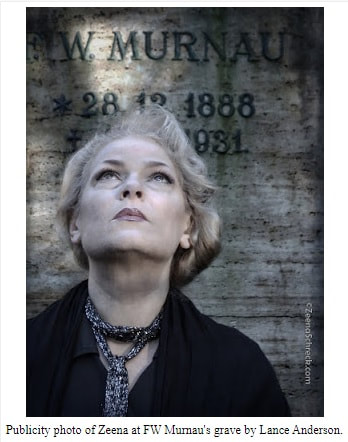 So, getting back to the cemetery field recordings: It was only by fluke, while taking photos at Murnau's grave, that my camera accidentally engaged the video record. It wasn't until later that day, when downloading my data from the day's shoot, I realized I'd inadvertently gotten some unexpected and pretty interesting sounds while at the grave. Luckily, there was still time to mix those in before the final edit and mastering. For some unknown reason, I've always had strange energy clashes with electronic devices; something's always malfunctioning with them in my case. I've come to expect these ‘accidental’ recordings of environment sounds, with both my audio recorder and my cameras video setting. Whenever it happens, I always discover something interesting, humorous or just uncanny and bizarre that gets added to my sound library. This reveals how much is occurring all the time that we humans normally filter out but which, when cut out of the normal flow of everyday life, can be wonderful auditory meditations. I'm sure that those unexpected sounds at the cemetery made a difference in enhancing an underlying eerie quality to the whole thing.”(5) Zeena’s field recordings directly tie into her concept of “sonic necromancy.” These field recordings she gathered communicate an additional essence of Murnau that would not have been present otherwise: “Sound art differs from conventionally composed music in that soundscapes are generally thought to be like paintings done with sound rather than matter. They may or may not necessarily tell a story. In this case, however, there is story. Between many years of magical ritual practices, as well as early-life theater and film training, which includes techniques in character development, sense memory and improvisation, a fusion of disciplined training in all these areas creates conducive conditions for summoning of the dead. While my magical training and ritual experience is probably more generally acknowledged than my theater training, I mention the latter only in relation to this music project because I'm playing various characters or roles throughout. Whether we are hearing Murnau's own thoughts in the opening and closing tracks, or the female Angel of Death who's come to usher Murnau away from this worldly experience, or the ‘bardo beings’ who inhabit the intermediate state between the end of one life and the beginning of the next. All of those voices are different characters revealing different levels of metaphysical existence and understanding.”(6) If BMTHOFWM sounds like a multifaceted release, it is because it certainly is. Though the EP only contains six tracks and clocks in at roughly 18 minutes, it is compact in its sound design, atmosphere, and ambitious scope. The first track of the EP, “Letter to Mother,” has Zeena reciting a letter Murnau wrote to his mother against a background of crashing waves. In this track, Zeena channels her aforementioned acting chops, mimicking a deeper voice that would be Muranu. It is a somber recital that sets a melancholy mood that permeates the release. Track two, “Ill Omens,” runs with this melancholy with a peppering of something menacing or foreboding. It is a track that is minimal on sound, but high on atmosphere. Closing one’s eyes, one can picture an old film with a scene of tiptoeing through a cave or a dimly lit forest, illuminated day-for-night style, while a Harryhausen-esque monster waiting to emerge from the shadows. The third track, “A Drive up the Coast,” chronicles the last moments of Murnau as he died in an auto accident while traversing the Pacific Coast Highway near Santa Barbara in 1931. The track begins jovial, with organ music composed by Zeena that evokes a funfair or a period appropriate party in the background. Sounds of an open car window woosh by before (spoiler alert!) the sounds of accelerations, followed by a scream, tires screeching, and a crash. Track four, “Tabu,” is a reference to Murnau’s final film, Tabu: A Story of the South Seas (1931) that was released shortly after his death. An early tiki film, the story depicts two lovers, Reri and Matahi, as they try to escape Reri’s fate of being made into a sacred maiden for their island’s deities. The first half of the song is the most industrial-sounding music on the EP, with some minimalist piston-percussions. The last half of the song switches gears to the exotica genre, with primitive drumming and shakers, that channels the likes of Martin Denny and Les Baxter. Over the music, Zeena, reaching into her experience of performing incantations, recites the same decree that was uttered in Tabu that denoted Reri as forbidden, and not to be touched by any man. “The Phantom Bridge” is the EP’s fifth track and this one digs right into the vampiric roots Murnau is best known for. A spoken word track, Zeena recites some of the inter titles from Murnau’s Nosferatu which in turn were taken from Stoker’s Dracula. The music in this track is, as the title suggests, ghostly, with spirituals wisps, shackling noises, tiny bells and chimes. The EP’s final track, “Endlich Daheim,” is perhaps the most ambitious track on the album, that not only underscores Murnau’s career, but demonstrates Zeena at her most artistic. Prior songs on the EP has Zeena reciting texts from other sources while “Endlich Daheim” contains both original organ music and lyrics by Zeena, sung in a haunting and beautiful style. A sound of a 1920s projector starting up beings the track with the music proper evoking the feelings of being at a funeral - Murnau’s funeral - with Zeena’s poetry acting as a eulogy. The end result is that BMTHOFWM is a superb solo debut for Zeena and an excellent experimental release all around. Atmospheric, haunting, and magical, but also cinematic and fully versed in filmic pop culture that it celebrates. Born from a macabre act of stealing the skull of Murnau, the EP easily could’ve embraced grotesquery or morbidness, but instead the CD comes off as sincere. Aside from these observations, Zeena herself had her own goals for the release: “Well, after a few years of unexpected obstacles, as well as unexpected serendipitous occurrences which led to creating much more material for this than I'd originally planned, I guess the main thing I wanted to accomplish was getting it completed at all! Jokes aside, the fact is, there's still someone out there who has taken and kept the skull from Murnau's grave. This is at the heart of the project. I wanted to pull all of the unusual elements surrounding this case together into one cohesive creative expression. The music in this project is created to facilitate opening the mind to all possible questions surrounding that event, and even to, on a transcendental and metaphysical level, provide even bigger answers.”(7) Five years after the act, the mystery of who absconded with Murnau’s skull remains unsolved. Of course, thoughts have drifted to Schreck as a possible culprit, which she both playfully and adamantly dismisses: “[S]ince many have already jokingly asked me – let's nip this in the bud right here – NO, it wasn't me!”(8) Sincere thanks for Zeena Schreck for allowing me to interview her for this writeup and providing the images. All images used in this article are copyrighted by Zeena Schreck and used with permission. More information about Zeena and her projects can be found at the following websites and social medias:
Website: https://www.zeenaschreck.com/ Facebook: https://www.facebook.com/ZEENA.Official.ZeenaSchreck/ Instagram: https://www.instagram.com/zeenaschreck_art/ Bandcamp: https://zeenaschreck.bandcamp.com/releases YouTube: https://www.youtube.com/user/ZeenaSchreckOfficial Endnotes 1. Nigel M Smith, “Nosferatu director’s head stolen from grave in Germany,” The Guardian, last modified July 14, 2015, https://www.theguardian.com/film/2015/jul/14/nosferatu-director-head-stolen-germany-grave-fw-murnau. 2. “Coming Soon From Zeena Schreck: Bring Me The Head of F.W. Murnau,” Heathen Harvest, last modified July 21, 2015, https://heathenharvest.wordpress.com/2015/07/21/coming-soon-from-zeena-schreck-bring-me-the-head-of-f-w-murnau/. 3. Zeena Schreck, email message to author, June 16, 2020. 4. Ibid. 5. Ibid. 6. Ibid. Bibliography “Coming Soon From Zeena Schreck: Bring Me The Head of F.W. Murnau.” Heathen Harvest. Last modified July 21, 2015. https://heathenharvest.wordpress.com/2015/07/21/coming-soon-from-zeena-schreck-bring-me-the-head-of-f-w-murnau/. Schreck, Zeena. Bring me the Head of F. W. Murnau. KCH KCHCD01. 2020. CD. Smith, Nigel M. “Nosferatu director’s head stolen from grave in Germany.” The Guardian. Last modified July 14, 2015. https://www.theguardian.com/film/2015/jul/14/nosferatu-director-head-stolen-germany-grave-fw-murnau. Posted by Nicholas Diak at 6:58 PM At long last, IT'S ALIVE! Congratulations to Mikey Bean for his long awaited mammoth, encyclopedic documentation of the roots of the Los Angeles deathrock scene, which was an integral part of the later goth movement. Within the 630 page history, is full chapter on Radio Werewolf which includes an exclusive interview with Zeena (sample pages below).
Can be purchased NOW directly at: http://www.lulu.com/shop/mikey-bean/phantoms-the-rise-of-deathrock-from-the-la-punk-scene/paperback/product-24320734.html Book description and product details in screenshot below. NEW YORK, April 17 Tony Sokol interviewes Zeena about Master of Dark Shadows documentary; a loving look at the iconic '60s TV series Dark Shadows, a Dan Curtis production[...] Demons of the Flesh author Zeena, an icon in the real magical world of the sixties, told Den of Geek, "Probably for many, Dark Shadows was a gateway-drug to becoming a budding occult explorer," the interdisciplinary artist and world renowned tantric Buddhist mystic continues. "The '60s were a weird window in time of occult explosion, where portals to dark mythologies could just open up to you through your prime-time TV screen, or daytime soaps as was the case with Dark Shadows. A manifestation of that particular Zeitgeist."
Read the FULL INTERVIEW HERE https://www.denofgeek.com/us/culture/occult/280580/dark-shadows-witch-was-as-influential-as-its-vampire 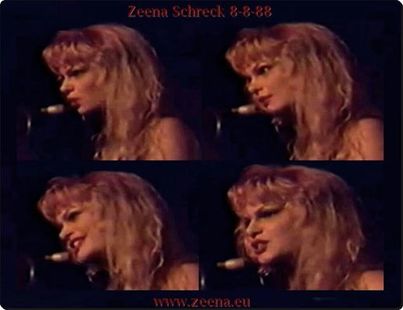 Flashback to 8-8-88: Today marks thirty years since Zeena's first public collaboration with music group Radio Werewolf, which led soon after to her becoming co-director as composer, musician, lyricist, singer, artist and art director. Music historian Mikey Bean interviewed Radio Werewolf for his forthcoming encyclopedic volume, 'Phantoms: The Rise of Deathrock from the L.A. Punk Scene.' The Radio Werewolf chapter covers a vast amount of yet unknown information about several key points in the bands development, from all members involved. Thanks goes out to Mikey Bean for granting permission to share a peek of this book, prior to release. The following passages are specifically in reference to the 8-8-88 rally at the Strand Theater in San Francisco. To follow updates on the 'Phantoms' release, go to this Facebook page: Phantoms: The Rise Of Deathrock From The La Punk Scene https://www.facebook.com/mikeys.book/ Original, Vintage Radio Werewolf Merchandise available on this site under: VINTAGE, ORIGINALS & COLLECTIBLES 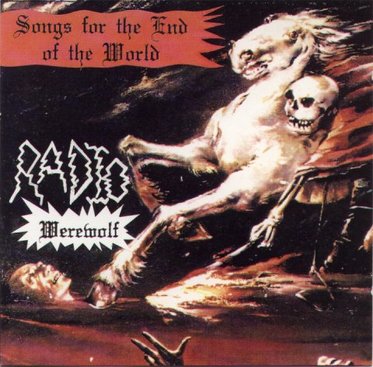 Radio Werewolf begin working on The Norse Eddas shortly before 8-8-88 Zeena: In Summer of '88, a couple of months after we'd met, Nikolas mentioned that he and Kirby were planning on doing an album of the Norse Eddas. Nikolas Schreck: …on rehearsing the adaptation of the Elder Edda, which formed the centerpiece of Radio Werewolf's second album Songs For The End Of The World. Zeena: He said, “I'm looking for a strong woman to play the role of a Valkyrie and you just might be the one I've been looking for.” Nikolas Schreck: Her artwork and creative writing, which she read to me, and her skills as an improvisatory keyboard player with a gift for haunting medieval melodies, her experience in theater as ritual, these were the many things we had in common as far as the mutual artistic approach that blossomed into our collaboration in the next phase of Radio Werewolf. Zeena: He knew I'd done theater pieces and had acting experience, and asked if I'd be interested. Now, the funny thing is, between '87-88, I'd been having a pleasant dalliance with King Diamond. Right around the time Nikolas asked me to participate in the Eddas recording, Kind Diamond said he'd like to find a way to bring me on tour with him but in order to do that, he would have had to work me into his act to justify my travel expenses. At that time, King Diamond had a stage act that involved a haunted house story with a scary old grandmother character and he asked if I'd consider wearing a latex mask to play the grandmother. Well, given the choice between playing a Valkyrie or playing an old grandmother in a latex mask, which would you choose?! (laughs) So obviously Nikolas, Kirby and I began working on what would become Songs For The End Of The World fairly early on. We were artists who would’ve collaborated as equals on something anyway, regardless of whether or not we got romantically involved, and regardless of Nikolas's then involvement with the first cast of Radio Werewolf. […] 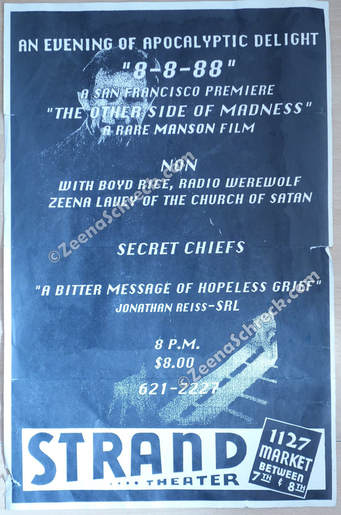 8-8-88 rally at Strand Theater SF Nikolas Schreck: Then in August, the 8-8-88 concert happened, the anniversary of the Manson murders. Zeena came to San Francisco from LA at my invitation, to do a reading at this concert to which Boyd Rice and I had agreed to several months before. Zeena: I was supposed to arrive at the venue with Boyd and Adam Parfrey. I wanted to get there a little early, as I usually do, but they wanted to wait until the last minute and opted instead to kill time eating dinner in Japan Town. Meanwhile, Nikolas and his girlfriend were still running around getting everything together for the performance, obviously with no help from the three of us. Zeena: The 8-8-88 rally was the only time the old line up of Radio Werewolf and the yet-to-be new line up of Radio Werewolf worked together. It would be the only performance that Nikolas, the original percussionist Wilhelm, and I ever performed live together. That marked the transition point spanning three phases of Radio Werewolf: 1) the Nikolas Schreck/Evil Wilhelm collaboration, 2) the solo Nikolas Schreck/The Fiery Summons, and 3) the Nikolas Schreck/Zeena collaboration. [...] Zeena: During the performance my cue was a particular organ chord that Nikolas would play; Boyd's part came before mine and when Nikolas played the cue Boyd was to step away from the podium to make room for the next in the line-up, me. When the time came for my part Boyd just stood there, I kept looking around wondering when he'd get it, his part was finished, but he stood there an interminably long time, just sort of zoning out. Judging by Boyd's and Adam's jitteriness that they expressed at dinner over the Geraldo crew filming it, I think that must have been what panicked him, they weren't yet used to that level of national attention. Nikolas Schreck: When the Geraldo Rivera [U.S. TV show] film crew had arrived at the theater they asked me in all seriousness if they could film my Satanic wedding ceremony with Zeena LaVey; they were very disappointed when I told them there was no such wedding planned! Zeena: Because of Boyd's stage fright, it left me about half the time I needed for what we'd planned for me to read…so I just hurriedly did my part and moved on. It was also tense during the performance because shortly before we went on, we learned of a call-in threat from someone with the intention of stabbing the participants on stage with syringes filled with AIDS infected blood. […] Zeena: I was not at all comfortable with the atmosphere immediately after the show and wanted to immediately leave, as was the original agreement. There was supposed to be a car waiting for me, which never materialised so I was stuck in the backstage area with a bunch of dips wanting to ape for the camera. There were some group photos taken and if you notice I'm at the far outer end…why? Because I didn't even want to be in the photos at all. I was the only one standing off to the side watching the others take photos but the ‘Anton LaVey fan-club’ all whined that I should be in the photos with them and that's why I'm actually half in, and half out, of those shots.
Nikolas Schreck: Me and Wilhelm gave an interview to Geraldo, and if you watch the interview you can already see the tension that comes across from us sitting together. Evil Wilhelm: During the show I looked around in disgust and said “this is just not fun anymore…”. Zeena: You could cut the tension with a knife, because on the one end of the spectrum you had these goofy newcomers to the CoS, getting off on their 15 minutes of media high, and then on the other end of the spectrum you had this silently smouldering Radio Werewolf drama between Wilhelm and Nikolas unfolding behind everyone else's drunken giddiness…as for me, I just wanted to go home. Fastforward 30 Years Zeena: Although we haven't collaborated on musical projects since Radio Werewolf ended in 1993, there are still a lot of similarities in theme and content to what we both do. Nikolas Schreck: These days, Zeena and I focus on solo performances and individual writing/art projects; we purposely don't attend each others' gigs for a variety of practical reasons, mostly having to do with maintaining respect for each artists' autonomy, and to dispel the moronic ‘Mommy and Daddy of Satanism’ idea which originated primarily from both the US Fundamentalist Christian AND Satanic factions. Zeena: We live and work entirely independently of each other these days. On a practical level, we learned long ago that it's very difficult for two very focused artists, who are always working on a continuous stream of projects, with unpredictable schedules, to attempt to live any sort of conventional co-habitation or ‘coupledom’ lifestyle. In addition to that, I've taken Buddhist Bodhisattva vows and am a yogini, which also necessitates specific ways of living. Nikolas Schreck: I’m flattered that [more than] thirty years after I started [Radio Werewolf] people are still enthusiastic and excited about it. I saw from the beginning that it’s something beyond…I can’t get away from it, but it isn’t ‘me’; I feel like I have a younger twin brother who did all this stuff and I have to deal with the consequences, that it’s like a child I brought into the world and I have to accept the responsibility of it. Zeena: For me, the most powerful, valuable and enduring lesson of all that came out of my Radio Werewolf years is the message of our final album: Love Conquers All. [End of excerpt] |
SUPPORT FOR WORKS IN PROGRESS
Zeena is an entirely independent, self-funded artist. Her livelihood and funding for creative projects rely solely on commissioned artwork, teaching and lecturing engagements, performances and purchases of her products and music, as well as from donations from private patrons and sponsors. If you would like to pledge your support towards the production costs of current works in progress, please use the PayPal donation button at the top of page. Thank you for your support of Zeena's work! Archives
May 2024
Categories
All
|
Zeena's Bandcamp page |
Copyright ©2024 Zeena Schreck. All rights reserved.
|





